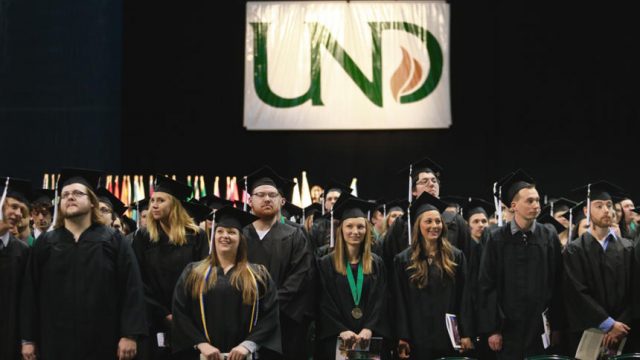The University System Isn’t Meant to Be an Employment Program for Professors and Bureaucrats

The UND Class of 2016 looks around as graduates process in for commencement Saturday at the Alerus Center in Grand Forks. photo by Eric Hylden/Grand Forks Herald
This letter to the editor in the Grand Forks Herald today is an unfortunate example of why higher education can often be its own worst enemy.
The missive, written by University of North Dakota Professor Marcus Weaver-Hightower, takes a haughty and belittling tone in response to critics of policies like tuition waivers used to attract out of state students.
“A small number of North Dakota legislators, perhaps misled by nativist sentiments at the highest levels of the U.S. government, recently have floated policy ideas about keeping almost everyone but the North Dakota-born out of our colleges and universities,” he writes.
“The thinking is apparently that ‘foreigners’ come and sponge off of our resources, then leave without contributing to North Dakota,” he continues.
Aiming snobby and insulting denunciations at skeptics of these policies is hardly a persuasive tactic. All the more so when the motivations are so clearly self serving.
Here’s a dose of reality: With 11 campuses, North Dakota has far more public institutions of higher education than is strictly necessary to serve our state’s students. The only way our state can sustain this overdeveloped university system is by recruiting students from out of state.
If we didn’t draw those students to our state through policies like tuition discounts and giveaways we would have to close down some of these campuses and some people like Mr. Weaver-Hightower would have to find work elsewhere.
[mks_pullquote align=”left” width=”300″ size=”24″ bg_color=”#ffffff” txt_color=”#000000″]Cramming more students on campus means more tuition revenue, more fees paid, more books bought. All of which translates into higher pay and more career advancement for people who work in higher education.[/mks_pullquote]
There’s also the fact that indiscriminate enrollment growth is good for the big business of higher education. Cramming more students on campus means more tuition revenue, more fees paid, more books bought. All of which translates into higher pay and more career advancement for people who work in higher education.
Which would be wonderful if the students brought into North Dakota stayed here. But they mostly don’t.
According to a ground breaking new study by the state into tuition waivers, officials found that students who enter the North Dakota University System from a North Dakota High School are staying in the state, while less than 1 out of 5 students who come from outside of the state are staying. What’s more, those students receiving tuition waivers are less likely to stay in North Dakota than those who do. “Contrary to the intent of the tuition waivers, the report found that only 32.3 percent of students who received these waivers for part or all of their tuition for bachelor’s degrees still were working in the state seven years after their first degree, compared with 40.6 percent who received no waivers,” reported Kevin Killough about the study.
Again, packing the campuses with out of state students is very good for the business of higher education, but it’s of dubious utility to the state if it puts taxpayers in the position of subsidizing an educated workforce for other states.
Like it or not, taxpayers don’t fund the North Dakota University System as an employment program for professors and bureaucrats.
What would be of great benefit to the state is if we increased completion rates at the universities. Currently they’re not very good. Currently at NDSU and UND just roughly a quarter of students graduate on-time with a four year degree. Just roughly 50 percent graduate after six years.
If we improved those rates – if more students finished their degrees at North Dakota institutions rather than transferring or dropping out – we could accomplish the goals policies like tuition waivers are supposed to be achieving (bringing more people to North Dakota to live and work) without the expenses associated with increasing enrollment.
But improving completion rates means accepting static or even declining enrollment levels, which in turn means less need for building projects and personnel on campus. That’s anathema to people like Weaver-Hightower, I’m afraid.
Quality is what serves the State of North Dakota best. Quantity is what best serves the interests of the higher education industry.




